The installation of solar panels and heat pumps in UK homes soared in 2023, driving the country to its highest-ever level of domestic low-carbon technology upgrades.
Registered solar photovoltaic (PV) installations rose nearly 30% to a post-subsidy record of 189,826 in 2023, according to the Microgeneration Certification Scheme (MCS).
Similarly, heat-pump installations were up 20%, reaching a record 36,799.
This growth drove a UK record for the total number of domestic renewable electricity and low-carbon heat technologies installations registered by MCS, which reached 229,618.
This brings the total MCS-certified installations of solar PV overall to 1,441,753 since 2009, equivalent to more than 5% of all UK households.
The near-record figure for home solar in 2023 is particularly significant because it came without any government support, whereas previous growth was driven by deadlines under the Feed-in-Tariff (FiT) subsidy scheme, which ended in 2019.
Below, Carbon Brief looks at MCS’s installation figures for 2023, picking out some of the most significant domestic developments.
Record clean energy growth
The UK had already recorded its “best-ever” year for renewable energy and low-carbon heat installations before 2023 came to end, as Solar Power Portal reported in December.
While solar PV and air-source heat pumps (ASHP) saw growth in their installation rates in 2023, other clean technologies dropped off somewhat.
By the end of the year, a record total of 229,618 MCS certified installations had been registered (there is the potential for a small change to the total, due to a lag with registrations, MCS told Carbon Brief).
This included a post-subsidy record 189,826 solar PV installations, up by a third from the 138,020 seen in 2022.
Solar Energy UK chief executive Chris Hewett said in a statement:
“Setting a post-subsidy record of almost 190,000 smaller-scale solar PV installations, and approaching the all-time record of 203,000, is truly a moment to celebrate. The solar industry is on a roll, particularly as we start to conclude work on the government-industry Solar Taskforce, whose roadmap for delivering 70GW [gigawatts] of capacity is due to be published in a couple of months.”
The number of MCS-registered ASHP installations grew to a record 36,799 in 2023 from 29,490 a year earlier. (The real number of heat pumps installed in the UK is likely to be higher, as there is currently no mandate for all low-carbon technology deployments to be certified, or reported in a single place.)
Bean Beanland, director for growth at trade association the Heat Pump Federation, tells Carbon Brief the growth in demand for ASHPs was being driven by increasing activity from “early movers”, as well as by the boiler upgrade scheme (BUS) subsidy, which was introduced in 2022 and increased in 2023.
The BUS initially offered a £5,000 grant for those installing an ASHP or biomass boiler and £6,000 for a ground-source heat pump (GSHP). This was raised to £7,500 for both ASHPs and GSHPs in October 2023.
Beanland adds:
“[Following the increase in the grant] one of our members went back to all the consumers who they had quoted during 2023, detailing the increase, but where they had not converted the opportunity. The result was a significant number of contracts, so the additional £2,500 has certainly made a difference.
“In parallel, the whole visibility of the technology is being driven by the likes of Octopus, Good Energy and OVO, with their very high-profile campaigns and the advent of time-of-use tariffs that improve the financial benefits considerably.”
Customers who are able to afford to deploy solar PV, a battery and a heat pump can use such tariffs to reduce operational cost, allowing the heat pump to compete with gas, he adds.
The number of GSHP installations fell from 3,420 to 2,469, while solar-thermal installations nearly halved, falling from 615 to 311.
Beanland says:
“The value of the BUS for ground-source is just far too low. Government has made a conscious decision to go for numbers rather than the highest efficiency by supporting air-source to a much greater extent. This has been compounded now that the BUS levels for air- and ground- are the same.”
The surge in ASHP means that low-carbon heating technologies still saw an overall increase in 2023, rising by 20% year-on-year, as reported by BusinessGreen.
Despite this growth, however, the installation of heat pumps remains a long way from hitting the UK government target of 600,000 installations per year by 2028.

While the MCS dashboard does not provide data on battery storage installations, a recent release from the company states that 2023 was a record-breaking year for the technology. MCS says batteries were the third most popular technology type to be installed in homes by its certified contractor base.
Of the 4,700 certified batteries registered with MCS, 4,400 were installed in 2023, it adds.
With the energy price cap on average domestic energy bills now sitting below £2,000 per year and installation costs having increased with inflation, it is unclear whether the high levels of solar PV installations in 2023 will be maintained this year.
Solar Energy UK’s chief communications officer Gareth Simkins says:
“Speculation is always a dangerous game. I think it is reasonable for current deployment rates – around 15,000 a month – to continue. This will not just be retrofits of course – we expect more newbuild homes to carry solar, too.”
Monthly solar installations hit highs
Last year saw monthly installations of rooftop solar PV start to hit the levels seen in 2015, when government subsidies were still available, as shown by the red bars in the figure below.
March 2023 saw 20,073 registered solar PV installations, putting it in the top 10 months seen in the UK. Both 11th and 12th places were claimed by months in 2023 too, with June seeing 18,049 installations and May seeing 17,787 installations.
The rest of the top 10 installation months are dominated by 2011, 2012 and 2015. This was driven largely by subsidy deadlines, with a rush seen ahead of cuts leading to record-high installation periods.

In 2012, the FiT subsidy for solar was cut in half, reducing from 43.3p per kilowatt hour (kWh) to just 21p per kWh. This cut returns from solar electricity from around 7% to 4%, according to the Guardian.
In doing so it almost doubled the payback period for households, with some seeing their £10,000-12,000 solar panels only being in credit after 18 years rather than 10, the Guardian reported at the time.
This change followed then-climate change minister Greg Barker launching a consultation into the subsidies in an effort to avoid the industry falling victim to “boom and bust“.
Following the change, installations fell by nearly 90%, according to Department of Energy and Climate Change figures reported in the Guardian.
Installations dropped from 26,941 in March 2012 to 5,522 in April 2012, according to MCS figures, although there was a further surge later that year.
Throughout 2013, installations remained relatively subdued, growing through 2014 before peaking again in 2015. Installations hit 25,614 in December 2015, but this came ahead of further FiT reduction in February 2016, which sent “shockwaves” through the sector and saw installations drop dramatically
The FiT came to an end in 2019, with the solar export guarantee brought in 2020, which sets a minimum price for electricity exported to the grid.
Following the resulting lull in installations, domestic solar PV has once again been growing. The difference this time is that there is no underlying subsidy driving growth, with rising energy bills and longer-term falls in technology costs making the technology increasingly appealing.
Speaking to Carbon Brief, Solar Energy UK’s Simkins says:
“Oddly enough, it shows the success of FiTs in creating a market for solar in the first place, with the industry now standing entirely on its own two feet without government support.”
Installation costs rise
The inflationary impacts of the Covid-19 pandemic and the subsequent energy crisis led to an increase in solar technology costs in 2023.
Consequently, installation costs have risen over recent years, according to MCS. Across every month in 2023, average installation costs sat above £10,000 – the only time in more than a decade that they have reached that level, as shown in the figure below.
This has been impacted by the scale of the installations to a certain extent, with the installation cost per kilowatt (kW) seeing a more limited increase. Across 2022, the average cost of installing solar per kW was £1,804 and in 2023 this rose to £2,020.
Moreover, in some months, solar was actually cheaper per kilowatt (kW) in 2023 than in 2022, MCS data shows.
It is also worth noting that the increase in the cost of solar installations has not been as dramatic as the increase in energy bills over the past couple of years.
The energy crisis drove up domestic energy bills from late 2021, as supply chain squeezes driven in part by the Russian invasion of Ukraine sent gas prices to record highs.
As a result, the default tariff price cap for consumers jumped from £1,277 per year in the six months to March 2022, to £1,971 over that summer, and then to £3,549 over the winter of 2022.
It then surged again to £4,279 over the first quarter of 2023, before it began to fall (the energy price guarantee came into force in October 2022, superseding the rate of the price cap, and limiting domestic energy bills to £2,500 initially).
The surge in domestic energy prices highlighted the exposure of the British energy system to fluctuations in international gas markets. In doing so, it is likely it helped drive uptake of domestic solar – as shown in the figure below – as households looked to cushion themselves from potential future surges.

Speaking to Carbon Brief, solar wholesaler Midsummer’s commercial director Jamie Vaux says installation costs are now coming down.
The high installation costs and long installation lead times in 2022, were driven by demand exceeding supply, he says. With new installers entering the market and mortgage rates and inflation hitting consumer spending, this has started to ease, he adds.
Average installation prices per kW peaked at £2,111 in April 2023, before slowly falling throughout the year.
Vaux explains:
“Essentially, those who had the funds available when the energy crisis hit have already had their installations, and while many still want solar, the rate stopped climbing so steeply and the curve flattened at the same time as more installers were there to meet the demand. It has become more competitive at the installation level, and installation costs have (gradually) fallen as a result.”
There is also currently a glut of solar modules, which could help prices continue to fall and stimulate further update of solar, according to Vaux.
There is currently “a year’s worth of modules already sitting in EU warehouses, and devaluing daily”, Vaux adds, meaning top-tier modules can be bought for a fraction of prices seen in 2022.
Solar Scotland
The area with the overall highest share of households with solar PV installations since the start of MCS data in 2009 is Stirling in Scotland, where 16.7% of households have solar PV (6,994 households).
Perhaps surprisingly, given their poorer insolation rates relative to other parts of the UK, Scottish local authorities appear four times in the top 10, as shown in the figure below.
Scotland’s housing policy means it is mandatory for solar to be fitted on all new build properties, helping to boost installation rates.

In terms of installations completed during 2023, the Isle of Anglesey came out on top, with 1,083 systems added, amounting to 3.5% of households.
The top 10 for last year is dominated by Welsh and Scottish local authorities, with just one English local authority making it into the list – South Cambridgeshire in ninth place.
There are five Scottish local authorities (Dumfries and Galloway, East Lothian, Perth, Moray and Kinross and Midlothian) and four Welsh local authorities (Isle of Anglesey, Ceredigion, Powys and Pembrokeshire).
The 10 local authority areas with the lowest percentage of solar PV installations since 2009 are all in London, with Kensington and Chelsea coming out on top with just 0.4% (or 297) of households having registered solar PV installed, according to MCS.
It is worth noting that due to the density of the households in London and other major cities, they are over-represented in the lowest percentage list for solar installations.
For example, Wandsworth – which comes out as having the tenth lowest rate of just 1.1% of households having solar PV – only has 1,496 installations.
Meanwhile, Torridge in Devon – which has the eighth highest rate of installations in the UK at 12.8% – has 3,899 solar PV installations. While this is more than double the number is Wandsworth, the much larger difference in percentage terms highlights the impact of population size in each local authority area.
The same is broadly true of 2023. While the area last year with the lowest installation rate was Derry City and Strabane, with just 73 installations (0.1% of households), the bottom ten is still dominated by London boroughs, which made up eight of the list.
Detached properties are the most common when it comes to solar PV installations, with 50,8193 of the MCS registered solar PV installations since 2009 (35.2%) having been fitted on detached properties, versus 447,415 on semi-detached, 288,886 on terraced, 187,131 on flats and apartments and 10,100 on other properties.
This means detached properties – which tend to be larger, with more roof area – are over-represented in terms of their share of solar installations, as shown in the figure below.

The post Analysis: Surge in heat pumps and solar drives record for UK homes in 2023 appeared first on Carbon Brief.
Analysis: Surge in heat pumps and solar drives record for UK homes in 2023
Greenhouse Gases
IEA: Renewables have cut fossil-fuel imports for more than 100 countries
More than 100 countries have cut their dependence on fossil-fuel imports and saved hundreds of billions of dollars by continuing to invest in renewables, according to the International Energy Agency (IEA).
It says nations such as the UK, Germany and Chile have reduced their need for imported coal and gas by around a third since 2010, mainly by building wind and solar power.
Denmark has cut its reliance on fossil-fuel imports by nearly half over the same period.
Renewable expansion allowed these nations to collectively avoid importing 700m tonnes of coal and 400bn cubic metres of gas in 2023, equivalent to around 10% of global consumption.
In doing so, the fuel-importing countries saved more than $1.3tn between 2010 and 2023 that would otherwise have been spent on fossil fuels from overseas.
Reduced reliance
The IEA’s Renewables 2025 report quantifies the benefits of renewable-energy deployment for electricity systems in fossil fuel-importing nations.
It compares recent trends in renewable expansion to an alternative “low renewable-energy source” scenario, in which this growth did not take place.
In this counterfactual, fuel-importing countries stopped building wind, solar and other non-hydropower renewable-energy projects after 2010.
In reality, the world added around 2,500 gigawatts (GW) of such projects between 2010 and 2023, according to the IEA, more than the combined electricity generating capacity of the EU and US in 2023, from all sources. Roughly 80% of this new renewable capacity was built in nations that rely on coal and gas imports to generate electricity.
The chart below shows how 31 of these countries have substantially cut their dependence on imported fossil fuels over the 13-year period, as a result of expanding their wind, solar and other renewable energy supplies. All of these countries are net importers of coal and gas.

In total, the IEA identified 107 countries that had reduced their dependence on fossil fuel imports for electricity generation, to some extent due to the deployment of renewables other than hydropower.
Of these, 38 had cut their reliance on electricity from imported coal and gas by more than 10 percentage points and eight had seen that share drop by more than 30 percentage points.
Security and resilience
The IEA stresses that renewables “inherently strengthen energy supply security”, because they generate electricity domestically, while also “improving…economic resilience” in fossil-fuel importer countries.
This is particularly true for countries with low or dwindling domestic energy resources.
The agency cites the energy crisis exacerbated by Russia’s invasion of Ukraine, which exposed EU importers to spiralling fossil-fuel prices.
Bulgaria, Romania and Finland – which have historically depended on Russian gas for electricity generation – have all brought their import reliance close to zero in recent years by building renewables.
In the UK, where there has been mounting opposition to renewables from right-wing political parties, the IEA says reliance on electricity generated with imported fossil fuels has dropped from 45% to under 25% in a decade, thanks primarily to the growth of wind and solar power.
Without these technologies, the UK would now be needing to import fossil fuels to supply nearly 60% of its electricity, the IEA says.
Other major economies, notably China and the EU, would also have had to rely on a growing share of coal and gas from overseas, if they had not expanded renewables.
As well as increasing the need for fossil-fuel imports from other countries, switching renewables for fossil fuels would require significantly higher energy usage “due to [fossil fuels’] lower conversion efficiencies”, the IEA notes. Each gigawatt-hour (GWh) of renewable power produced has avoided the need for 2-3GWh of fossil fuels, it explains.
Finally, the IEA points out that spending on renewables rather than imported fossil fuels keeps more investment in domestic economies and supports local jobs.
The post IEA: Renewables have cut fossil-fuel imports for more than 100 countries appeared first on Carbon Brief.
IEA: Renewables have cut fossil-fuel imports for more than 100 countries
Greenhouse Gases
Cropped 8 October 2025: US government shutdown; EU loses green space; Migratory species extinction threat
We handpick and explain the most important stories at the intersection of climate, land, food and nature over the past fortnight.
This is an online version of Carbon Brief’s fortnightly Cropped email newsletter. Subscribe for free here.
Key developments
Forest fund delays and cuts
TFFF BEHIND SCHEDULE: Brazil’s flagship forest fund, the Tropical Forest Forever Facility (TFFF), is “running behind schedule as officials deliberate on how to structure the complex financial vehicle” in time for COP30, Bloomberg reported. The “ambitious” fund aims to raise $125bn to help countries protect rainforests “using investment returns from high-yielding fixed-income assets”, it explained. However, the outlet reported that investor events have either not been held or cancelled, while officials are still mulling “possible structures” for the fund.
CUTS DEEP: Environmentalists fear that “sweeping spending cuts for forest protection” by Argentina’s “pro-business libertarian” president, Javier Milei, could endanger the country’s forests, Climate Home News reported. The impacts of these cuts are “already becoming evident”, contributing to deforestation – particularly in the northern Gran Chaco region, environmentalists told the outlet. According to Argentine government data, the country lost about 254,000 hectares of forest nationwide in 2024. Milei – who has said he wants to withdraw Argentina from the Paris Agreement – faces a “crucial midterm election” in October that could make environmental deregulation even easier, the outlet wrote.
BANKING ON THE AMAZON: A new report found that 298 banks around the world “channelled $138.5bn” to companies developing new fossil-fuel projects in Latin America and the Caribbean, Mongabay reported. The experts behind the study told the outlet: “Some major banks have adopted policies to protect the Amazon, but these have had little impact, as they do not apply to corporate-level financing for oil and gas companies operating in the Amazon.” Mongabay approached every bank, but only JPMorgan Chase responded, declining to comment.
-
Sign up to Carbon Brief’s free “Cropped” email newsletter. A fortnightly digest of food, land and nature news and views. Sent to your inbox every other Wednesday.
‘Green to grey’
‘600 FOOTBALL PITCHES’: Europe is losing “green space…at the rate of 600 football pitches a day”, according to a new, cross-border investigation by the “Green to Grey Project”, the Guardian reported. The outlet – part of the Arena for Journalism in Europe collaboration of journalists and scientists behind the project – added that Turkey accounted for more than a fifth of the total loss in Europe. While nature “accounts for the majority of the losses”, the research showed that the EU is also rapidly building on agricultural land, “with grave consequences for the continent’s food security and health”, it continued.
‘TWICE AS HIGH’: Conducted by 40 journalists and scientists from 11 countries, the investigation found that the “natural area” lost to construction in the EU was “twice as high as official estimates”, Le Monde reported. Despite Brussels setting a 2011 target to “reduce the EU’s yearly land take” to 800km2 – “more than 100,000 football fields” – the EU is “artificialising more than 1,000km2 of land per year”, it added.
KEY DRIVERS: While the “main drivers of land loss across Europe” are housing and road-building, Arena for Journalism in Europe found many instances of construction “that serve only a minority or that are not built based on public need”, such as luxury tourism sites. Between 2018 to 2023, “an area the size of Cyprus” in nature and cropland was lost to construction, they added. Researchers who “scrutinised millions of pixels in search of lost natural areas” found that Finland’s tourism boom is “encroaching on the last remaining sanctuaries” in Lapland, another Le Monde story reported.
News and views
‘INTRACTABLE’ OFFSETS: A new review paper found that the failure of carbon offsets to cut emissions is “not due to a few bad apples”, but “down to deep-seated systemic problems that incremental change will not solve”, the Guardian wrote. Study co-author Dr Stephen Lezak told the outlet: “We have assessed 25 years of evidence and almost everything up until this point has failed.” The worst of these “intractable problems” were with “issuing additional credits” for “non-additional”, “impermanent” and double-counted projects, the Guardian noted.
INSTITUTIONALISING AGROECOLOGY: The Cuban government issued a national decree providing a “more explicit legal framework” for the implementation of agroecological principles across the country, according to a release from the Caribbean Agroecology Institute. The decree also announced a new national fund for promoting agroecology. Yamilé Lamothe Crespo, the country’s deputy director of science, innovation and agriculture, “emphasised that agroecology is a model capable of responding to the global climate crisis”, teleSUR reported.
ZERO PROGRESS TO ZERO HUNGER: The world has “made no improvement” towards achieving the “zero hunger” Sustainable Development Goal since it was set in 2015, according to a new report from the UN Food and Agriculture Organization. The report said that “ongoing geopolitical tensions and weather-related disruptions” have contributed to “continued instability in global food markets”. Separately, a new report from the Energy and Climate Intelligence Unit thinktank estimated that a “year’s worth of bread” has been lost in the UK since 2020 due to extreme weather impacting wheat harvests, the Guardian reported.
MEATLESS MEDIA: More than 96% of analysed climate news stories across 11 (primarily US-based) outlets “made no mention of meat or livestock production as a cause of climate change”, according to analysis by Sentient Media. Sentient, a not-for-profit news organisation in the US, looked at 940 stories to assess the reported causes of greenhouse gas emissions. Around half of the stories included mention of fossil fuels, it said. Covering the report, the Guardian wrote: “The data reveals a media environment that obscures a key driver of the climate crisis.”
FRAUGHT PATH: One-fifth of migratory species “face extinction from climate change”, according to a new report by the UN’s migratory species convention, covered by Carbon Copy. The “warning” comes as climate change and extreme weather are “altering their ranges [and] shrinking habitats”, the Mail & Guardian wrote. Oceanographic Magazine noted that the North Atlantic right whale is “forced to make migratory detours into dangerous pockets of the ocean” due to warming seas. Down to Earth reported that the range of Asian elephants is “shifting east” in “response to anthropogenic land-use and climate change”.
GOODBYE, GOODALL: Dr Jane Goodall, the groundbreaking English primatologist, died at the age of 91 last week. BBC News noted that Goodall “revolutionised our understanding” of chimpanzees, our “closest primate cousins. The outlet added that she “never wavered in her mission to help the animals to which she dedicated her life”. CNBC News reported that Goodall followed a vegan diet due to factory farming and the “damage done to the environment by meat production”. She also “encouraged” others to follow her example, the outlet said.
Spotlight
What the US government shutdown means for food, forests and climate
This week, Carbon Brief explains the US government shutdown – now in its second week – and its implications for food, forests, public lands and climate change.
The US federal government shut down at 12:01 eastern daylight time on 1 October, as Congress failed to agree on a bill to keep funding the government and its services.
This is the 11th time that the government has shut down in such a fashion; previous shutdowns have lasted anywhere from a few hours to longer than a month.
As a result of the shutdown, 750,000 federal employees have been furloughed, or placed on unpaid leave. Others, whose work has been deemed “essential”, are working without pay.
(A law passed during a shutdown in US president Donald Trump’s first term guarantees back pay and benefit accrual for furloughed employees. However, the White House has argued that the law does not necessarily guarantee these benefits.)
Some agencies have seen close to 90% of their employees furloughed.
With a reopening date uncertain, Carbon Brief explored what the shutdown means for food, forests and climate.
Food and farming
According to the agency’s “lapse of funding” plan, the US Department of Agriculture (USDA) planned to furlough about half of its employees for the duration of the shutdown.
Among the activities put on hold during the funding lapse are the disbursement of disaster-assistance payments for farmers impacted by extreme weather events. The Farm Service Agency, which oversees these payments, will also not process any new loans during the shutdown, such as those that provide assistance to farmers during the harvest.
The Natural Resources Conservation Service, an arm of the USDA with a mission to help private landowners “restore, enhance and protect forestland resources”, has seen more than 95% of its staff furloughed, effectively halting all conservation efforts within the agency.
Certain animal-health programmes – such as the one addressing the highly pathogenic avian influenza outbreak – will continue, but others will shutter for the duration of the funding lapse. Long-term research on animal and plant diseases will also cease.
Forests and fires
The US Forest Service falls under the purview of the USDA. Employees responsible for “responding [to] and preparing for wildland fires” will continue to work during the shutdown; however, “hazardous fuels treatments” – such as prescribed burns or pruning to reduce fuel loads – will be reduced under the agency’s plan. Furthermore, state grants for fire preparedness and forest management “may be delayed”.
Work on forest restoration projects may potentially continue “on a case-by-case basis”, the plan said.
The Bureau of Land Management (BLM), a subdivision of the Department of the Interior, will furlough around 43% of its employees, according to its contingency plan. Staff dedicated to fire management will continue to work while “carryover balances” are available, but the number of staff working will be reduced once these funds are exhausted.
Climate change and research
Across the federal government, most research activities are being put on hold, including conference travel and the issuing of new grants.
Grant recipients may continue carrying out research “to the extent that doing so will not require federal staff” and while funds are available, according to the National Science Foundation’s operational plan. This does not include researchers at federal agencies, such as the Environmental Protection Agency, US Geological Survey and the National Oceanic and Atmospheric Administration (NOAA).
The funding-lapse plan set out by the Department of Commerce said that NOAA will continue its prediction and forecasting activities, as well as maintain “critical and mission-related” programmes related to research satellites. However, “most research activities” will cease.
Similarly, NASA’s shutdown plan indicates continuing support for satellite operations, but a pause on research activities – except for those “aligned with presidential priorities”.
Watch, read, listen
MORAINE DILEMMA: A new PBS documentary walked through ancient Inca paths in the Andes to understand how modern communities are confronting the loss of Peru’s glaciers.
SUBSIDISING ‘EXPLOITATION’: A DeSmog investigation revealed how farmers convicted of “exploiting migrant workers” continue to claim “millions in taxpayer-funded subsidies”.
GROUND TRUTHING: A podcast from the Hindu looked back at 20 years of India’s Forest Rights Act, meant to “address historic injustices” towards the country’s Indigenous communities.
DEEP DIVE MANUAL: Mongabay journalists shared how they investigated Brazil’s shark-meat purchases that were subsequently served in schools, prisons and hospitals.
New science
- The frequency of “economically disastrous” wildfires increased sharply after 2015, with the highest disaster risk in “affluent, populated areas” in the Mediterranean and temperate regions | Science
- A “strictly protected” forest in Tuscany had maximum summertime temperatures that were, on average, nearly 2C cooler than those of nearby productive forests over 2013-23 | Agricultural and Forest Meteorology
- Between 2010 and 2020, the water consumed by global crop-growing increased by 9%, putting “additional pressure on limited water resources” | Nature Food
In the diary
- 9-15 October: 2025 World Conservation Congress of the International Union for Conservation of Nature (IUCN) | Abu Dhabi, United Arab Emirates
- 10-17 October: World Food Forum 2025 | Rome
- 16 October: World Food Day | Global
- 25 October: Ivory Coast presidential election
Cropped is researched and written by Dr Giuliana Viglione, Aruna Chandrasekhar, Daisy Dunne, Orla Dwyer and Yanine Quiroz. Please send tips and feedback to cropped@carbonbrief.org
The post Cropped 8 October 2025: US government shutdown; EU loses green space; Migratory species extinction threat appeared first on Carbon Brief.
Greenhouse Gases
Q&A: How countries are using biofuels to meet their climate targets
From canola farmers in Canada to car owners in India, biofuels have become the subject of everyday debate across the world.
Liquid biofuels feature heavily in the climate plans of many countries, as governments prioritise domestic energy security amid geopolitical challenges, while looking to meet their climate targets and bolster farm incomes.
Despite a rapid shift towards electrified transportation, biofuels continue to play a leading role in efforts to reduce road-transport emissions, as they work well with many existing car engines.
At the same time, biofuels are expected to play an important role in decarbonising sectors where emissions are particularly challenging to mitigate, such as shipping, trucking and aviation.
Heated debates continue around using food sources as fuel in the face of record hunger levels, given competing demands for land and crops.
Despite these arguments, biofuels are seeing heightened demand bolstered by a strong policy push, particularly in developing countries.
They are expected to feature heavily on the COP30 agenda this year as a key feature of the host Brazil’s “bioeconomy”.
Below, Carbon Brief unpacks what biofuels are, their key benefits and criticisms, plus how they are being used to meet climate targets.
- What are biofuels?
- What are the most common biofuels being used today?
- What are the main arguments for biofuels?
- What are some of the main criticisms of biofuels?
- How are countries using biofuels to meet their climate targets?
- How could climate change impact biofuel production?
What are biofuels?
Bioenergy refers to all energy derived from biomass, a term used to describe non-fossil material from biological sources. Biofuels, in turn, are liquid fuels that are produced from biomass.
These sources are wide-ranging, but commonly include food crops, vegetable oils, animal fats, algae and municipal or agricultural waste, along with synthetic derivatives from these products.
Glossary
Biomass
Non-fossil material of biological origin
Biofuel
Fuels produced directly or indirectly from biomass
Feedstock
Types of biomass used as sources for biofuels, such as crops, grasses, agricultural and forestry residues, wastes and microbial biomass
Bioenergy
All energy derived from biofuels
Bioethanol
A biofuel used as a petrol substitute, produced from the fermentation of biomass from plants like corn, sugarcane and wheat
Biodiesel
A biofuel used as a diesel substitute, derived from vegetable oils or animal fats through a process called transesterification
The different types of biomass are referred to as “feedstocks”. They are converted to fuel through one or more processes, such as fermentation or treating them with high temperatures or hydrogen.
Biofuels are frequently blended with petroleum products in an effort to reduce emissions and reliance on fossil-fuel imports.
Experiments to test whether vegetable oils could run in combustion engines began in the early 1900s. In a 1912 paper, Rudolf Diesel – the inventor of the diesel engine – presciently noted that these oils “make it certain that motorpower can still be produced from the heat of the sun…even when all our natural stores of solid and liquid fuels are exhausted”.

An extract from Rudolf Diesel’s 1912 paper, published in the Proceedings of the Institution of Mechanical Engineers, outlining the importance biofuels could assume in the future. Credit: Proceedings of the Institution of Mechanical Engineers (1912)
Biofuels are divided into four “generations”, based on the technologies and feedstocks used to synthesise them.
| Type of biofuel | Source |
| First-generation | Food crops (eg, sugarcane, corn, wheat, rice) |
| Second-generation | Non-edible crops and materials (eg, straw, grasses, used vegetable oil, forest residues, waste) |
| Third-generation | Aquatic materials (eg, algae) |
| Fourth-generation | Genetically modified algae, bacteria and yeast, as well as electrofuels, synthetic fuels and e-fuels |
First-generation biofuels
The first – and earliest – generation of biofuels comes from edible crops, such as corn, sugarcane, soya bean and oil palm. Large-scale commercial production of these fuels began in the 1970s in Brazil and the US from sugarcane and corn, respectively.

Bioethanol, for instance, is drawn from the fermentation of sugars in corn, sugarcane and rice. Biodiesel is derived from vegetable oils – such as palm, canola or soya bean oil – or animal fats, through a process called transesterification, which makes them less viscous and more suitable as fuels.
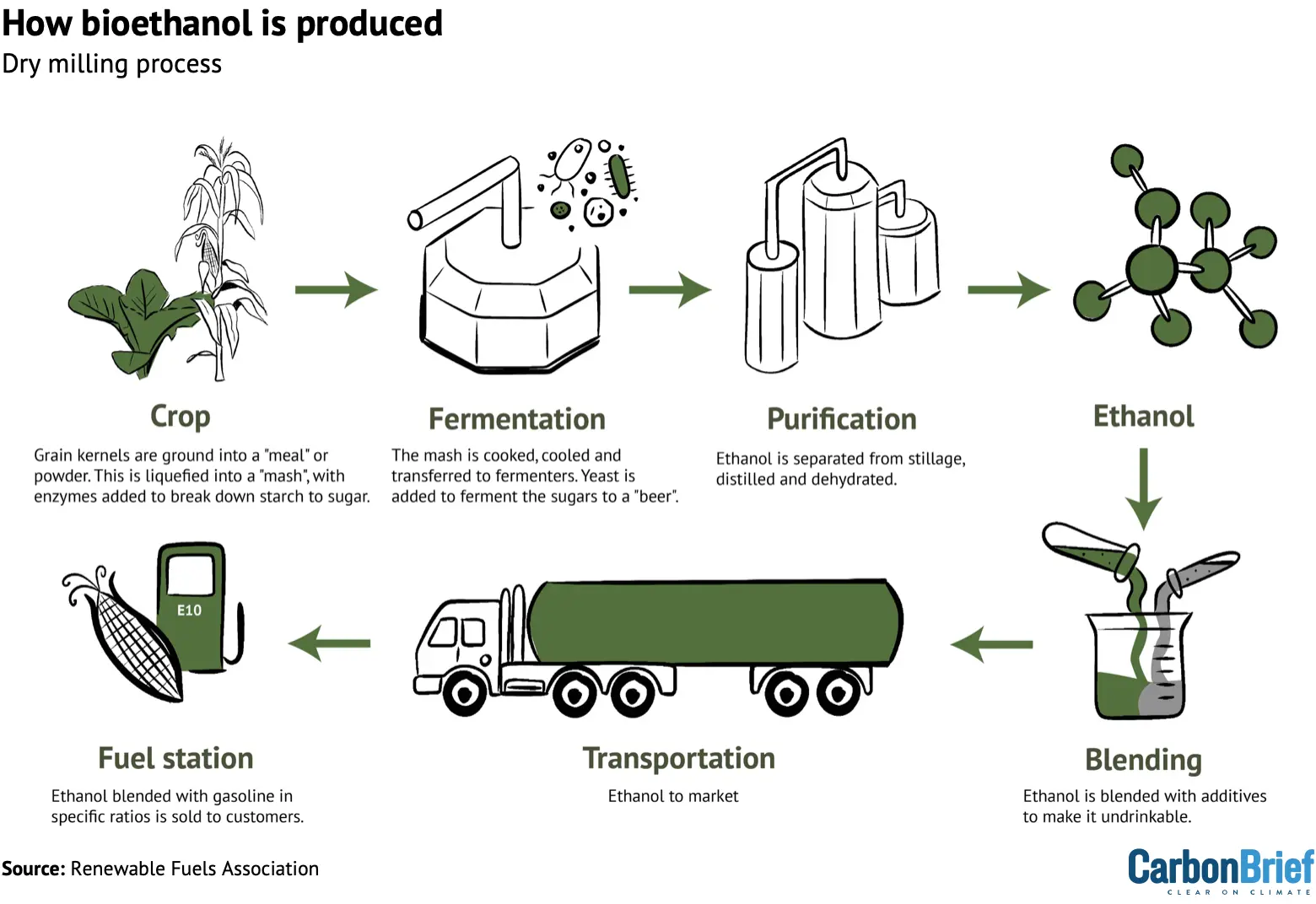
Because they are derived directly from food crops, experts and campaigners have expressed concerns over the impacts of first-generation biofuels on forests, food security and the environment, as well as indirect land-use change impacts. (See: What are some of the main criticisms of biofuels?)
Several studies have found that the land-use emissions of first-generation biofuels are severely underestimated, but other experts tell Carbon Brief that this depends on how and where the crops are grown, processed and transported.
According to Dr Angelo Gurgel, principal research scientist at the Massachusetts Institute of Technology (MIT) Center for Sustainability Science and Strategy, the “big image that biofuels are bad” is not always accurate. Gurgel explains:
“Some biofuels can be better than others, varying from place to place and feedstock to feedstock. It depends on where you produce them, how much farmers can increase yields, how effectively a country’s regulations help avoid land-use change and how closely it is connected to international markets.
“Some options may be very, very good in terms of reducing emissions and other options probably will be very bad.”
Second-generation biofuels
Second-generation biofuels are extracted from biomass that is not meant for human consumption.
Feedstocks for these biofuels are incredibly varied. They include agricultural waste, such as straw and corn stalks, grasses, forest residues left over from wood processing, used vegetable oil and solid waste. They can also be made from energy crops grown specifically to serve as biofuels, such as jatropha, switchgrass or pongamia.

Derived from “waste” or grown on “marginal” land, second-generation biofuels were developed in the early 2000s. These fuels aimed to overcome the food security and land-use issues tied to their predecessors, while increasing the amount of fuel drawn out from biomass, compared to first-generation feedstocks.
These feedstocks are either heated to yield oil or “syngas” and then cooled, or treated with enzymes, microorganisms or other chemicals to break down the tough cellulose walls of plants. They can be challenging to process and present significant logistical and land-use challenges.
Third-generation biofuels
Third-generation biofuels are primarily derived from aquatic organic material, particularly algae and seaweed. While the US Department of Energy began its aquatic species programme in 1978 to research the production of biodiesel from algae, algal biofuel research saw a “sudden surge” in the 1990s and “became the darling” of renewable energy innovation in the early 21st century, says Mongabay.
Because algae grows faster than terrestrial plants, is high in lipid (fatty organic) content and does not compete with terrestrial crops for land use, many scientists and industry professionals consider third-generation biofuels an improvement over their predecessors.
However, high energy, water and nutrient needs, high production costs and technical challenges are key obstacles to the large-scale production of algae-based biofuels. Since the early 2010s, many companies, including Shell, Chevron, BP and ExxonMobil, have abandoned or cut funding to their algal biofuel development programmes.
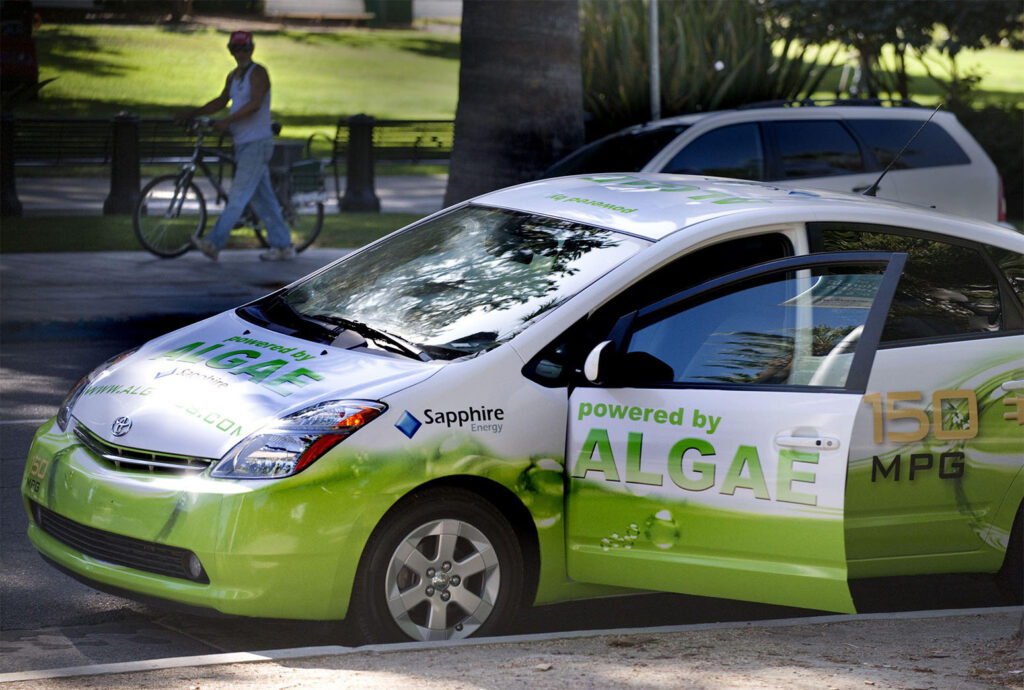
Fourth-generation biofuels
Genetically modified algae, bacteria and yeast engineered for higher yields serve as the feedstock for fourth-generation biofuels. These fuels have been developed more recently – from the early 2010s onwards – and are an area of ongoing research and development.
Some of these organisms are engineered to directly or artificially photosynthesise solar energy and carbon dioxide (CO2) into fuel; these are called solar biofuels.
Others – called electrofuels, synthetic fuels or e-fuels – are produced when CO2 captured from biomass is combined with hydrogen and converted into hydrocarbons through other processes, typically using electricity generated from renewable sources.
Fourth-generation biofuels are technology- and CO2-intensive and expensive to produce. They also run up against public perception and legal limitations on genetically modified organisms, as well as concerns around biosafety and health.
What are the most common biofuels being used today?
Bioethanol is the most commonly used liquid biofuel in the world, followed by biodiesel.
In 2024, global liquid biofuel production increased by 8% year-on-year, with the US (37%) and Brazil (22%) accounting for the largest overall share of production, according to the 2025 Statistical Review of World Energy from the Energy Institute.
Other countries that saw a notable increase in production between 2023-24 were Sweden (62%), Canada (39%), China (30%), India (26%) and Argentina (24%).
Bioethanol is the most commonly used biofuel in the world, with a consumption rate of 1.1m barrels of oil equivalent per day in 2024, according to the report. This is closely followed by biodiesel, at 1m barrels of oil equivalent per day.
In 2024, the US, Brazil and the EU accounted for nearly three-quarters of all biofuels consumed globally. However, while India’s biofuel demand grew by 38%, demand for biofuels in the EU fell by 11% in 2024, according to the review, echoing outlooks that show that middle-income countries are driving biofuel growth.
The chart below shows how biofuel production and consumption have changed since 2000, and how they are projected to change through 2034.
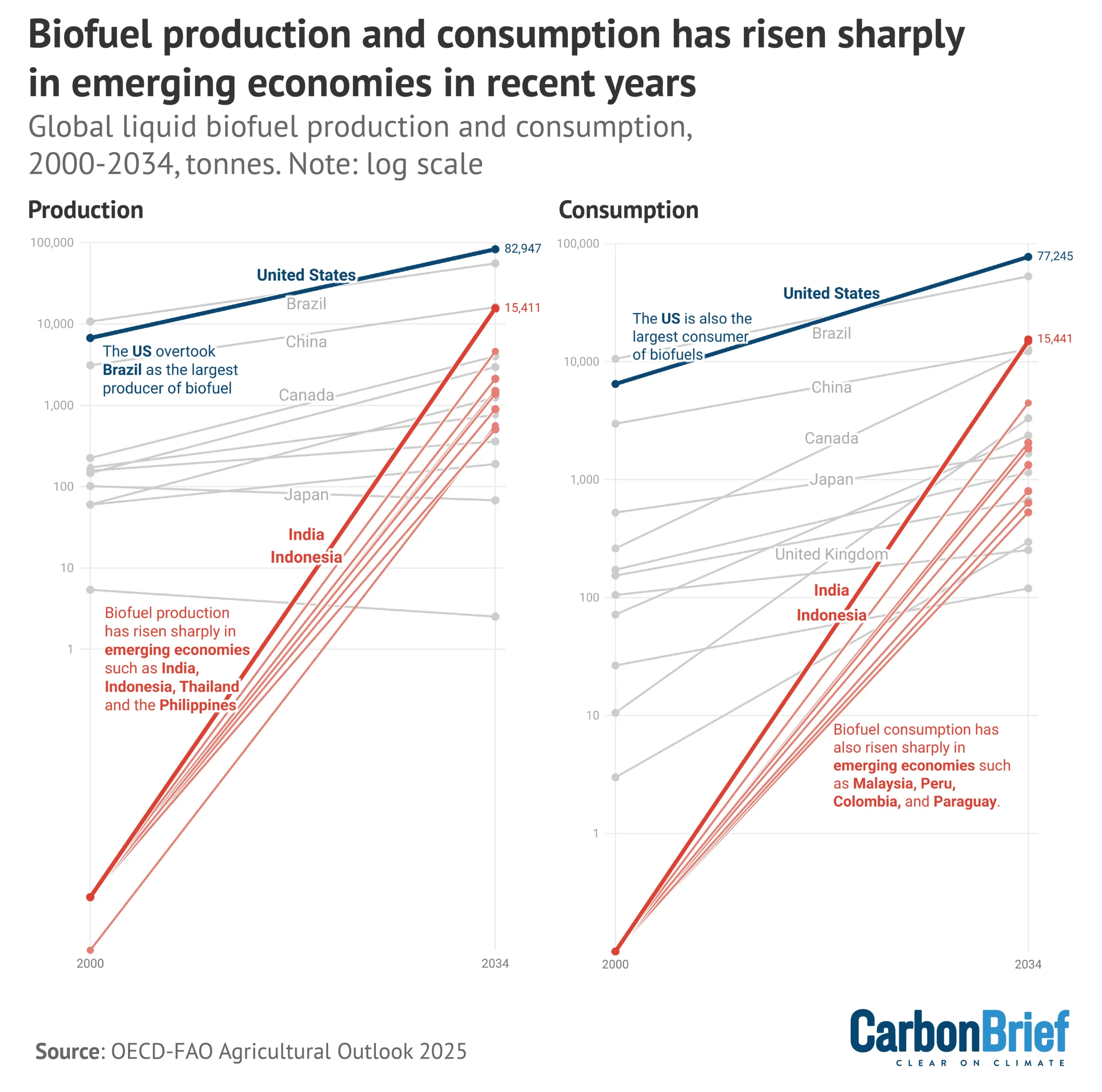
What are the main arguments for biofuels?
From lowered oil imports and emissions through to boosting farm livelihoods, countries that have boosted biofuels programmes cite several benefits in biofuels’ favour.
‘Renewable’ energy and lowered emissions
Biofuels are often described as “renewable” fuels, since crops can be grown over and over again.
In order to achieve this, crops for biofuels must be continuously replanted and harvested to meet energy demand. Growing crops – particularly in the monoculture plantations typically used for growing feedstocks – can require high use of fossil fuels, in the form of machinery and fertiliser. Furthermore, in the case of wood as a feedstock, regrowth can take decades.
While some biofuels offer significant emissions reductions, others, such as palm biodiesel, generate similar or sometimes higher emissions as fossil fuels when burned. However, ancillary emissions for biofuels are much smaller than for oil and gas operations.
One of the main cited benefits of biofuels is that plants capture CO2 from the atmosphere as they grow, potentially serving to mitigate emissions. However, several lifecycle-assessment studies have questioned just how much plants can offset emissions. These studies come up with varying estimates based on feedstock types, geography, production routes and methodology.
This divergence is echoed in the UN Intergovernmental Panel on Climate Change’s (IPCC) Sixth Assessment Report (AR6), which points to “contrasting conclusions” even when similar bioenergy systems and conditions are analysed.
Per the report, there is “medium agreement” on the emissions-reduction potential of second-generation biofuels derived from wastes and residues by 2050.
At the same time, the IPCC adds that “technical land availability does not imply that dedicated biomass production for bioenergy…is the most effective use of this land for mitigation”.
It also warns that larger-scale biofuel use “generally translates into higher risk for negative outcomes for greenhouse gas emissions, biodiversity, food security and a range of other sustainability criteria”.
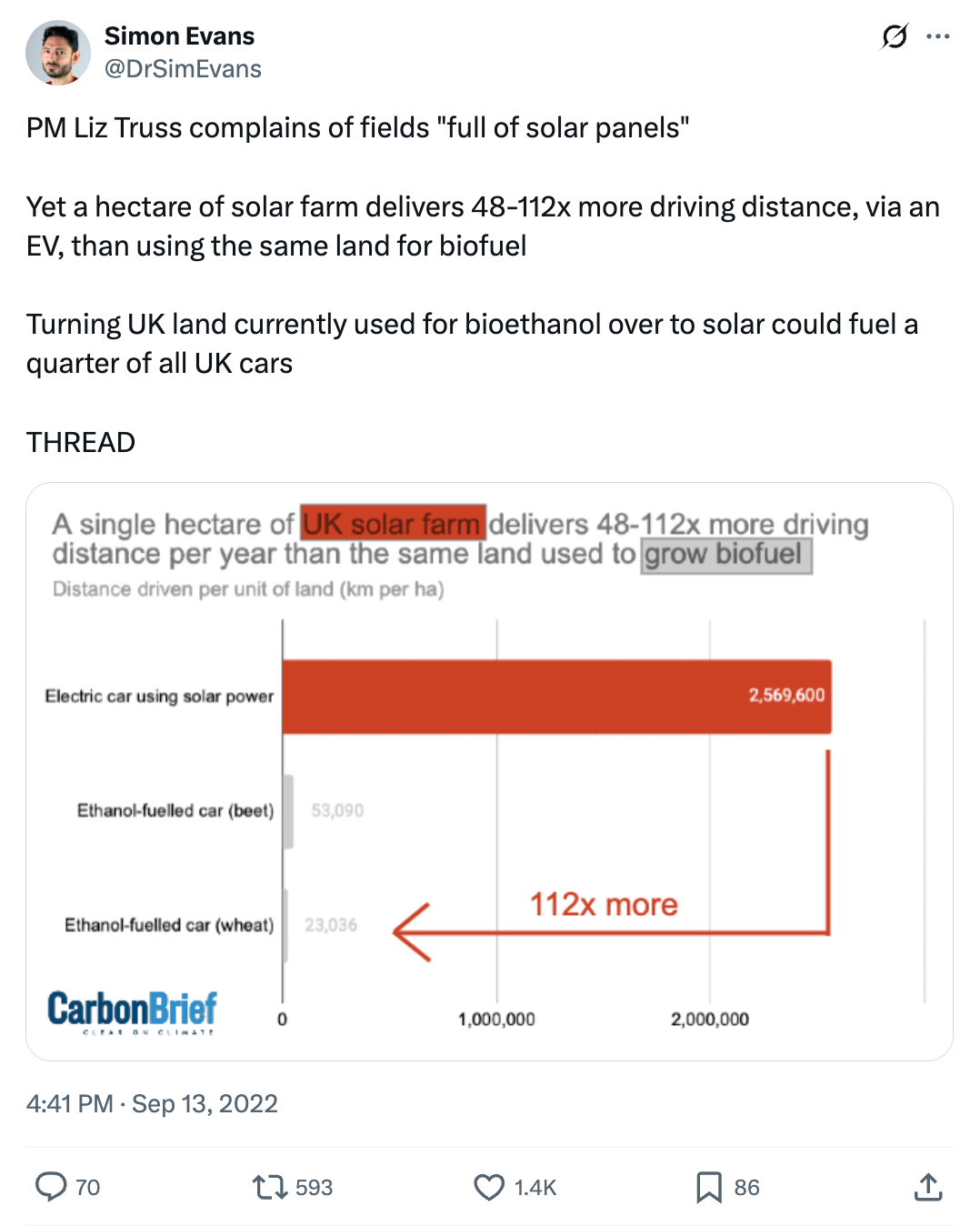
Along with the IPCC, many other groups and experts – including the UK’s Climate Change Commission – have called for a “biomass hierarchy”, pointing to a limited amount of sustainable bioenergy resources available and how best to prioritise their use.
Use in hard-to-abate sectors
In many countries, such as the US and UK, biofuels are part of a standard grade of diesel and petrol (gasoline) available at most fuel pumps.
Biofuels have also been the leading measure for decarbonising road transport in emerging economies, where electric vehicle systems were not as developed as in many western nations.
According to the International Energy Agency (IEA), most new biofuel demand is coming from these countries, including Brazil, India and Indonesia.
Biofuels are also one of the key options being explored to decarbonise the emissions-heavy, but “hard-to-abate”, sectors of aviation and shipping.
The AR6 report notes that the “faster-than-anticipated adoption of electromobility” has “partially shifted the debate” from using biofuels primarily in land transport towards using them in shipping and aviation.
At the same time, experts question how this can be done sustainably, given the limited availability of advanced biofuels and the rising demand for them.
Government reports – such as those released by the EU Commission – recognise that, in some circumstances, so-called sustainable aviation fuels (SAFs) could produce just as many emissions as fossil fuels when burned in order to power planes.
However, SAFs do generally – although not always – have a lower overall “lifecycle” carbon footprint than petroleum-based jet fuel. This is due to the CO2 absorbed when growing plants for biofuels, or emissions that are avoided by diverting waste products to be used as fuels.
Unlike the road sector, where “electrification is mature…aviation and shipping cannot be electrified so easily”, says Cian Delaney, fuels policy officer at the Brussels-based advocacy group Transport & Environment (T&E).
According to a 2025 T&E briefing, the 2030 demand for biofuels from global shipping alone could require an area the “size of Germany”. Delaney tells Carbon Brief:
“In aviation in particular, where you still need some space to transition, you still need a certain amount of biofuels. But these biofuels should be advanced and waste biofuels derived from true waste and residues, and they are available in truly limited amounts, which is why, in parallel, we need to upscale the production of e-fuels [synthetic fuels derived from green hydrogen] for aviation.”
In February this year, more than 65 environmental organisations from countries including the US, Indonesia and the Netherlands wrote to the International Maritime Organization, urging its 176 member states to “exclude biofuels from the industry’s energy mix”.
The organisations cited the “devastating impacts on climate, communities, forests and other ecosystems” from biofuels, cautioning that fuels such as virgin palm oil are often “fraud[ulently]” mislabelled as used cooking oil – a key feedstock for SAF.
Meanwhile, the AR6 report has “medium confidence” that heavy-duty trucks can be decarbonised through a combination of batteries and hydrogen or biofuels. And despite growing interest in the use of biofuels for aviation, it says, “demand and production volumes remain negligible compared to conventional fossil aviation fuels”.
Energy security and reducing import dependence
In many countries, such as India and Indonesia, biofuels are seen as a part of a suite of measures to increase energy security and lessen dependence on fossil-fuel imports from other countries. This imperative received increasing emphasis after the Covid-19 pandemic and Russia’s war on Ukraine.
In developing countries, the “main motivation” behind biofuel policy is to find an alternative to excessive dependence on imported fossil fuels that are a “major drain” on foreign exchanges and subject to volatility and price shocks, says Prof Nandula Raghuram, professor of biotechnology at the Guru Gobind Singh University in New Delhi.
Raghuram, who formerly chaired the International Nitrogen Initiative, tells Carbon Brief that, in order for developing countries to “earn those precious dollars to finance our petroleum imports”, they have to export “valuable primary commodities”, such as grain and vegetables, at the cost of nutritional self-reliance. He adds:
“And so we have to see the biofuel approach as not so much a proactive strategy, but as a sort of reactive strategy to use whatever domestic capacity we have to produce whatever domestic fuel, including biofuels, to reduce that much burden on the exchequer for imports.”
Boost to agriculture
Many governments also see biofuels as an alternative income stream for farmers and a means to revitalise rural economies.
An increasing demand for biofuels could, for example, offer farmers higher returns on their crops, attract industry and services to agrarian areas and help diversify farm incomes.
In 2023, a report by the International Labour Organization (ILO) and the International Renewable Energy Agency (IRENA) estimated that the liquid biofuel industry employed approximately 2.8 million people worldwide.
The bulk of these jobs were in Latin America and Asia, where farming is more labour-intensive and relies on informal and seasonal employment. Brazil’s biofuel sector alone employed nearly one million people in 2023, according to the report.
Meanwhile, North America and Europe accounted for only 12% and 6% of biofuel jobs in 2023, respectively, according to the report.
The chart below shows the number of jobs in the biofuel sector in the top 10 biofuel-producing countries.

Delaney points out that biofuel-related jobs account for less than 1% of all jobs in the EU, adding that the “most-consumed biofuel feedstocks” in the bloc are vegetable oils that are imported from countries such as Brazil and Indonesia. (See: How are countries using biofuels to meet their climate targets?)
He tells Carbon Brief:
“Despite strong biofuels mandates in the EU, the sector didn’t create as many jobs in the end for EU farmers, but, instead, benefited the big fuel suppliers and industry players.”
What are some of the main criticisms of biofuels?
Despite their widespread use and increasing adoption, experts recognise that biofuels “may also carry significant risks” and cause impacts that can undermine their sustainability, if not managed carefully.
Production emissions, land-use change and deforestation
The different chemical processes involved in making biofuels require varying amounts of energy and, therefore, the associated emissions depend on how “clean” a producer country’s energy mix is.
At the same time, growing biofuel crops often relies on emissions-intensive fertilisers and pesticides to keep yields high and consistent. (See Carbon Brief’s detailed explainer on what the world’s reliance on fertilisers means for climate change.)
Biofuel production processes, such as fermentation, also release CO2 and other greenhouse gases, including methane and nitrous oxide.
MIT’s Gurgel tells Carbon Brief that it is “relatively straightforward” to measure these direct emissions from biofuel production.
However, given how different countries account for deforestation, tracking direct land-use change emissions related to biofuel production is slightly more challenging – although still possible, Gurgel says. These emissions can come from clearing forests or converting other land specifically for growing energy crops.
For example, in many tropical forest countries, native rainforests and peatland have been cleared to grow oil palm for biodiesel or sugarcane for bioethanol.
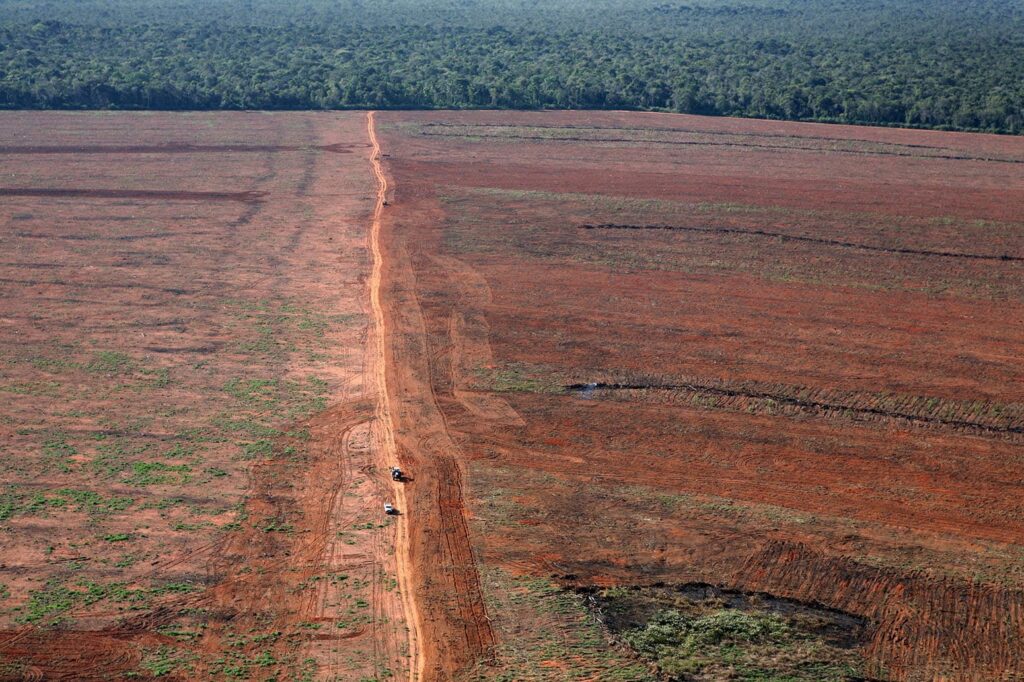
According to one 2011 study by the Centre for International Forestry Research and World Agroforestry (CIFOR-ICRAF), it could take more than 200 years to reverse the carbon emissions caused by clearing peatland to grow palm oil.
Gurgel tells Carbon Brief:
“What is really very hard – I would say impossible – to measure are the indirect impacts of biofuels on land.”
Indirect land-use change occurs when a piece of land used to grow food crops is used instead for biofuels. This can, in turn, require deforestation somewhere else to produce the same amount of crops for food as the original piece of land.
Indirect land-use change can mean a loss of natural ecosystems, with “significant implications for greenhouse gas emissions and land degradation”, according to a 2024 review paper.
Gurgel explains:
“If you provoke a chain of reactions in the market, that can lead to expansion of cropland in another region of the world and then this can push the agricultural frontier further and cause some deforestation…It’s quite hard to know exactly what’s going to happen and those things are interactions in the market that are impossible to measure.”
The “best that scientists can do” to determine if such a “biofuel shock” could indeed cause land-use change in a forest or grassland elsewhere “is try to project those emissions using models, or do very careful statistical work that will never be complete”, he adds.
Delaney, from Transport and Environment, contends that there is enough scientific research to “show that indirect land-use change is real” and to quantify the expansion of “certain food and feedstocks into high-carbon stock” areas, such as forests.
While this is “not easy” to do, he points to the European Commission’s indirect land-use change directive, the accompanying methodology and its scientific teams who study agricultural expansion rates. Delaney continues:
“What we all agree with at this point is that indirect land-use change exists, that it’s a problem, that certain feedstocks like palm and soya are particularly problematic from this perspective and that it is an issue that we need to tackle and capture in the best possible way.
“You cannot just be vague and descriptive without having proper figures behind it – and I think that’s something that at least the EU have tried and that they continue trying to implement. And I hope that, at the global level as well, this will be more recognised.”
Impacts on food, biodiversity and water security
Biofuel-boosting policies have been subjected to intense scrutiny during periods of global food-price spikes in 2008, 2011 and 2013.
Following the spikes, critics attributed increasing biofuel production as a major factor in the near-doubling of cereal prices. Studies have shown that they played a more “modest” role in some of these spikes and a more substantial one in others.
Severalexperts have linked food-price spikes to protests in north Africa and the Middle-East, including the Arab Spring.

In more recent years, the “food vs fuel debate” has come back to the fore since the start of the war in Ukraine in 2022.
This was in part due to the world’s reliance on Ukraine and Russia’s food and energy systems – particularly some of the most food-insecure countries, who had to contend with record-high food prices that peaked in March 2022, but still persist. The war also saw heightened calls for the US and EU to overturn biofuel-boosting policies to free up land to increase domestic food production and bring down food prices.
In developing countries, such as India, the use of cereals and oils to make biofuels while large sections of the population still lack access to adequate nutrition has attracted criticism from experts.
While first-generation biofuels rely on fertilisers to guarantee consistently high yields, second-generation biofuels could directly compete with feed for livestock or their return to soil as nutrients.
According to a 2013 report by the panel of scientists that advises the UN Committee on World Food Security (CFS):
“All crops compete for the same land or water, labour, capital, inputs and investment, and there are no current magic non-food crops that can ensure more harmonious biofuel production on marginal lands.”
This competition, along with clearing forests and other ecosystems for cropland, has consequences not just for emissions, but also for biodiversity, water and nutrients.
According to one 2021 review paper, local species richness and abundance were 37% and 49% lower, respectively, in places where first-generation biofuel crops were being grown than in places with primary vegetation. Additionally, it found that soya, wheat, maize and palm oil had the “worst effects” on local biodiversity, with Asia and central and South America being the most-impacted regions.

Biofuels’ impact on water resources, similarly, is highly crop- and location-specific.
For instance, growing a “thirsty” crop such as sugarcane in Brazil could have minimal impacts on local water resources, due to the region’s abundant rainfall. But in drought-prone India, experts have estimated that a litre of sugarcane ethanol requires more than 2,500 litres of water to produce and relies entirely on irrigation. Research has also found that nearly half of China’s maize crop requires irrigation to grow.
According to agricultural economist Dr Shweta Saini, meeting India’s 2025-26 biofuels target will require 275m tonnes of sugarcane, 6m tonnes of maize and 5.5m tonnes of rice. According to one 2020 study cited by Bloomberg columnist David Fickling, increasing sugarcane production to meet India’s biofuel targets “could consume an additional 348bn cubic metres of water…around twice what is used by every city” in the country.
Prof Raghuram tells Carbon Brief:
“Water resources are drying up everywhere in the country and by incentivising, through policy, a water-guzzling industry like this, we are inviting a sustainability crisis.”
‘Feedstock crunch’
Another concern surrounding biofuels is that there may not be enough supply to go around to meet rising demand. The IEA described the potential shortfall as a “feedstock supply crunch” in a 2022 report.
Fuels derived from the most commonly used waste and residues, in particular, could be approaching supply limits, the IEA warns, as these fuels satisfy both sustainability and feedstock policy objectives in the US and EU.
Consumption of vegetable oil for biofuel production is expected to soar by 46% over 2022-27, the report says. Meanwhile, the world is estimated to “nearly exhaust 100% of supplies” of used cooking oil and animal fats within the decade.
For the world to stay on a net-zero trajectory, “a more than three times production increase” would be required, the report adds. It warns that if the limited availability of second-generation feedstocks continues unchanged, “the potential for biofuels to contribute to global decarbonisation efforts could be undermined”.
The chart below shows the biofuel demand share of global crop production from 2022-27.

How are countries using biofuels to meet their climate targets?
Broadly, biofuel policies are divided into two categories.
Technology “push” policies focus on the research and development of new technologies and include measures such as research funding, pilot plants and government support for commercialising nascent technologies.
Meanwhile, market “pull” policies drive demand for existing and emerging biofuels through measures such as “biofuel blending mandates” – where countries prescribe a certain percentage of biofuel with fossil fuels – and tax breaks for producers and vehicle owners.
US
The US Renewable Fuel Standard (RFS) is the world’s largest existing biofuel programme. Its mandates are keenly watched and contested by the country’s farm and petroleum lobbies.
Under RFS, the US Environmental Protection Agency sets out minimum levels of biofuels that must be blended into the US’s transport, heating and jet fuel supplies.

Under the policy, oil refiners can either blend mandated volumes of biofuels into the nation’s fuel supply or buy credits – called Renewable Identification Numbers (RINS) – from those that do.
While the programme sets out emissions reduction targets, the environmental impacts of cropland expansion and monoculture driven by the policy have been cause for concern by experts.
According to one 2022 study, the RFS programme increased US fertiliser use by 3-8% each year between 2008-16 and caused enough domestic emissions from land-use change that the carbon intensity of corn ethanol was “no less than that of gasoline and likely at least 24% higher”. Additionally, the programme’s impacts on biodiversity have not yet been fully assessed.
In June 2025, the Trump administration announced plans to expand the biofuel mandate to a “record 24.02bn gallons” next year – an 8% increase from its 2025 target – while seeking to discourage imported biofuels.
EU
In the EU, policymakers have promoted biofuels since 2003 to reduce emissions in the transport system. As part of the EU’s Renewable Energy Directive (RED), biofuels have been explicitly linked to emissions targets.
Under the current iteration of RED (REDIII) – revised as part of the EU’s Fit for 55 package – EU countries are required to either achieve a share of 29% of renewable energy in transport or to reduce the emissions intensity of transport fuels by 14.5%. Additionally, it sets out a sub-target for “advanced biofuels” of 5.5% and excludes the use of food and feed-based biofuels in aviation and shipping.
In 2015, the European Commission acknowledged that the indirect land-use change emissions of first-generation biofuels could “fully negate” any emission savings by biofuels. The commission capped the use of first-generation biofuels in each member country at 7% of all energy used in transport by 2020, but did not announce plans to phase them out.
As of 2021, nearly 60% of all biofuels used in the EU were still made from food and feed crops, according to analysis by Oxfam. While the latest RED legislation continues to push for the use of advanced and waste biofuels, campaigners warn that a lack of clear definitions could increase the risk of “loopholes” and fraud, exacerbated by increased demand.
T&E’s Delaney tells Carbon Brief:
“You’re putting a lot of pressure on the land – you might require a lot of pesticides and irrigation – and there is not even enough land in Europe for this. How can you make sure true sustainability safeguards are in place so that you’re not actually driving additional demand for land in [biodiverse countries such as] Brazil?”
Brazil
Brazil has the world’s oldest biofuels mandate, dating back to the 1970s, established in a bid to insulate the country from expensive oil imports.
In 2017, Brazil announced a state policy called RenovaBio that set out national carbon intensity reduction targets for transport, decided biofuel mandates and created an open market for biofuel decarbonisation carbon reduction credits called CBIO.
In October 2024, Brazil enacted a “Fuels of the Future” law that replaced RenovaBio, with president Lula declaring that “Brazil will lead the world’s largest energy revolution”. The law aims to boost biofuel and sustainable aviation fuel (SAF) use, increasing biodiesel blending mandates by 1% every year starting in 2025 until it reaches 20% by March 2030.
Biofuels now account for 22% of the energy that fuels transport in Brazil and its ethanol market is “second in size only” to the US.
In June this year, Brazil announced that the country was increasing its biofuel blending mandates from 1 August in a bid to make the country “gasoline self-sufficient for the first time in 15 years”, reported Reuters.
Indonesia
As the world’s biggest palm oil producer, Indonesia has continued to raise its biodiesel blending mandates to meet its domestic energy needs.
The country first introduced mandatory biodiesel blending in 2008, at 2.5%. The mandate is currently at 40% in 2025 and, starting next year, could go up to 50% with an eventual goal of 100%.
While Indonesia’s president Prabowo Subianto has stated that implementing 50% blending could save the country $20bn in reduced diesel imports, the move would need an estimated 2.3m hectares of land, including protected forests, resulting in the “country’s largest-ever deforestation project”, according to Mongabay.
It could also compete with palm oil meant for domestic and international food markets, impacting already soaring prices and signalling the “end of cheap palm oil”.
India
India has quickly joined the ranks of major biofuel producers, due to high-level political support, policies and a diversity of feedstocks. In 2023, India launched the Global Biofuels Alliance as one of its key priorities of its G20 presidency.

Biofuel mandates are outlined in the country’s National Policy on Biofuels, first published in 2009 and subsequently amended in 2018 and 2022. In 2022, India achieved its 10% ethanol blending target ahead of schedule and is pursuing a 20% blending target by 2025, as well as a 5% biodiesel blending target by 2030.
India’s rapid biofuel push, however, has been criticised by food security experts as hunger levels rise, for its impact on endemic rainforests and, most recently, by vehicle owners for the impact of blended fuel on car engines.
Prof Raghuram says:
“From a sheer governance angle and sustainability angle, there are a lot of compromises being made to somehow push this whole thing. Even the land available in India is shrinking, as various reforms and dilution of environmental safeguards in the last 10 years have made it relatively easier to convert farm and forest land for non-agricultural purposes.”
China
China developed its first biofuel policies over 20 years ago and is one of the world’s biggest biofuel producers.
In 2017, China announced a new mandate expanding the use of fuel including bioethanol from 11 trial provinces to the entire country by 2020. However, Reuters and South China Morning Post reported that this was suspended in 2020. Only 15 provinces still maintain biofuel mandates, according to the US Department of Agriculture, which notes that a “lack of meaningful support for domestic biofuel consumption while aggressively promoting electric vehicles indicates a strategic choice to pursue transportation decarbonisation through electrification rather than liquid biofuels”.
At the same time, biofuel production in China grew by 30% in 2024, according to the Energy Institute’s Statistical Review.
While most of China’s biofuel production is grain-based, tax incentives for ethanol production have been gradually phased out and alternative biofuels have been incentivised, according to the IEA. China is currently piloting a scheme to increase biodiesel consumption at home, even as it exports biodiesel and used cooking oil to the EU and US.
How could climate change impact biofuel production?
Despite the well-documented impacts of climate change-induced extreme weather on land, agriculture and forests, there is currently little scientific literature examining how continued warming will impact global biofuel production.
One 2020 study found that bioethanol availability globally could drop – by 23% under a “very high emissions scenario” and by 4.3% under a “low emissions” scenario by 2060 – “if climate change risk is not adequately mitigated” and corn continues to be the dominant feedstock.
The study “encourages” changing out corn for switchgrass as a key source of bioethanol.
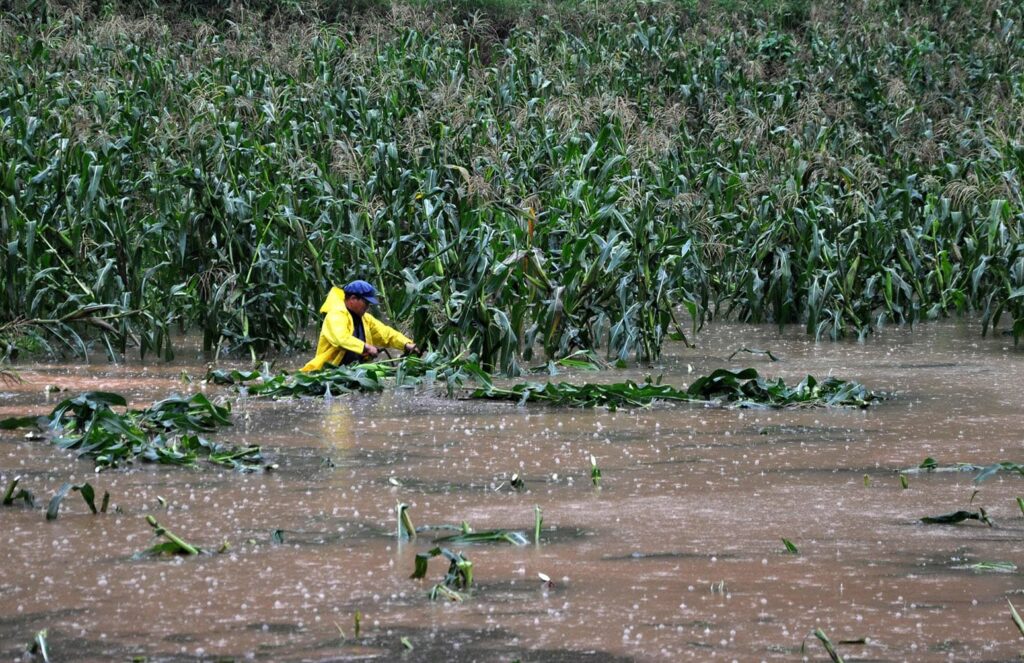
Another 2021 study examining the viability of China’s planned biofuel targets estimated that energy crop yields in China in the 2050s will decrease significantly compared to the 2010s, due to the impacts of climate change.
It found that climate change is expected to have a “substantial impact” on the land available for biofuel production in the 2050s, under both scenarios used in the study.
Gurgel, from MIT, tells Carbon Brief that it is “very hard to take into account how much climate change will damage bio-energy production” at this point, given the uncertainty of what emissions pathway the world will follow.
While most climate models “do a very good job” at forecasting average temperature change in the future, they do an “average job” at projecting rainfall change, or how many extreme weather events countries will see in the future, he says.
This is important because many biofuel crops, such as sugarcane and palm oil, are water-intensive and thrive in regions with abundant rainfall, but yields may fail in drier parts of the world that could see more drought.
Given this “cascade of uncertainties”, he continues, “we don’t have a clear picture of how bad the future [of agriculture] will be – we just know it will be more challenging than today”.
Delaney, meanwhile, asks whether investing in biofuels, which will be impacted by climate change, is a “good investment” for the long term. He tells Carbon Brief:
“I think these are the questions that we need to ask ourselves when we see – not just in India, but Indonesia, Brazil, everywhere around the world right now – this growing appetite for biofuels. Can we really keep the promises that we made at the end of the day?”
The post Q&A: How countries are using biofuels to meet their climate targets appeared first on Carbon Brief.
Q&A: How countries are using biofuels to meet their climate targets
-
Climate Change2 years ago
Spanish-language misinformation on renewable energy spreads online, report shows
-
Climate Change2 months ago
Guest post: Why China is still building new coal – and when it might stop
-
Climate Change Videos2 years ago
The toxic gas flares fuelling Nigeria’s climate change – BBC News
-

 Greenhouse Gases1 year ago
Greenhouse Gases1 year ago嘉宾来稿:满足中国增长的用电需求 光伏加储能“比新建煤电更实惠”
-

 Climate Change1 year ago
Climate Change1 year ago嘉宾来稿:满足中国增长的用电需求 光伏加储能“比新建煤电更实惠”
-
Greenhouse Gases2 months ago
Guest post: Why China is still building new coal – and when it might stop
-

 Carbon Footprint2 years ago
Carbon Footprint2 years agoUS SEC’s Climate Disclosure Rules Spur Renewed Interest in Carbon Credits
-
Renewable Energy3 months ago
US Grid Strain, Possible Allete Sale












